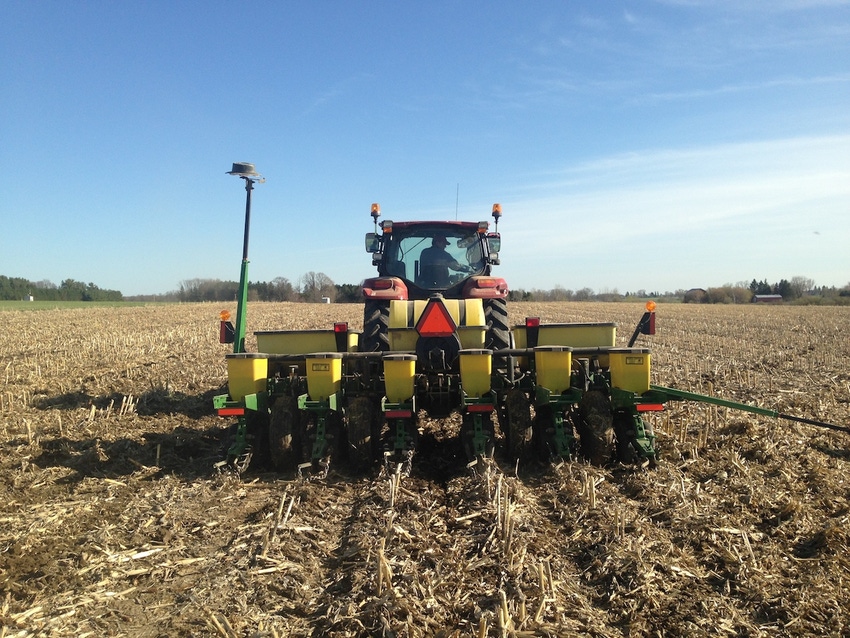
Think DifferentA new west central Wisconsin farmer proves area farmers wrong by making no-till succeed.It was a tough transition without much local advice, experimenting with weed control, fertilizer applications and building a no-till planter business.Local university research station, inspired by farmer, now conducting no-till trials to benefit all area farmers.
March 31, 2016

No-till doesn't work here. That was the message Carl Oberholtzer heard from new neighbors when he moved to west-central Wisconsin from the Chesapeake Bay area in 2000. Soils were too wet and too cold for no-till to work, they said, and he saw little reason to doubt them.
For five years he practiced rotational grazing and watched as fields with less than 1% organic matter doubled and then doubled again, with some fields reaching as much as 5.5% organic matter. When he returned to crop farming, he didn't want to lose that gain, so he began experimenting with no-till.
Tough no-till transition
"We haven't increased the organic matter, but we've maintained it," says Oberholtzer. "As we add cover cropping, we hope to begin increasing it again."
With no one to turn to in the area for advice, making the transition wasn't easy. Oberholtzer set up his own planter, sharing it with another farmer interested in trying no-till. It was a learning experience and one that gave neighbors something to laugh at, he recalls.
"Some of what we had for crops early on was worth laughing at," he admits. "As we refined our weed control and fertilizer applications and saw improved results, we had more interest."
What he learned was the need to plant into a clean field with no growing weeds and fertilizing early and heavy. As interest grew, requests for help led to opening The Planter Shop, where he modifies planters for no-till. He also serves as a resource to other farmers and collaborates with Jason Cavadini, agronomist, University of Wisconsin Marshfield Agriculture Research Station, Marshfield, Wis.
Cavadini had seen the benefits of no-till on his family’s farm in western Wisconsin and in graduate school at Purdue. He found resistance to the concept in the Marshfield area, but began to transition the research station to no-till, demonstrating equipment and holding field days for a growing number of farmers in transition.
Surrounded by culture of no
"There was a group of people interested in making it work, but the general culture was that it doesn't work," recalls Cavadini. "Our no-till farmer group is a support group. Rather than argue if it is worth doing, we are looking for the best way to make it work."
Cavadini describes the region as hosting the largest concentration of dairy farms in the world, mostly small dairies with many growing in size. Manure-fed soils are productive silt loam at the surface with a dense and increasingly clay layer 8-12 inches down, resulting in poor drainage. Subsurface tiles haven't worked well in the past due to the tight soils; however, tiling is now on the upswing.
Water infiltration, soil health benefits
Cavadini suggests that no-till and cover crops may negate the need to invest in tile, and Oberholtzer agrees. When 5 inches of rain fell this past September, Cavadini recalls sinking to his ankles in conventionally tilled fields two days later, while being able to chop corn silage in a no-till field across the road.
"Normally, an inch of rain delays field work for a week in this area," he says. "We've had a few cases where after even one year of no-till, we see major benefits in soil health and water infiltration."
Oberholtzer is excited at similar benefits he has seen with no-till. He hopes to see more as he adds cover crops, such as more beneficial and timely manure applications. "Manure management is critical, and there is no better time to apply than on a growing crop," says Oberholtzer. "My goal is to apply all our manure on a growing cover crop in the fall and then stay off in the spring. We aren't there yet."
Finding right cover crops
Like his initial attempts at no-till, making cover crops work with such a short post-harvest period before freeze-up has had mixed success. Rye planted in fall 2014 didn't do well, but Oberholtzer blames his own half-hearted attempt with it. He has higher hopes for triticale planted after cutting corn for silage this past fall.
"I hope to make feed out of it late spring and then follow with soybeans," he says. "I would like to get three crops in two years with a good rotation."
Making any new practice in an area work is challenging, notes Oberholtzer. He hopes Cavadini's efforts will make a difference. "We've helped Jason get his planter set up so he can document no-till benefits on the research farm. With depressed crop and milk prices, we are seeing more interest as a way to save money with less fuel. However, we have to be able to show a good yield, like we had this past year. It was our best crop ever."
In his no-till and cover crop program, Cavadini isn't necessarily shooting for publishable data. "The farmers I work with don't care about that," he says. "They just want to be able to walk through fields or plots and observe no-till benefits with their own eyes."
About the Author(s)
You May Also Like



